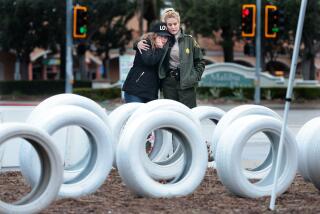Deal OKd on Car-Pool Lanes : Caltrans, Sen. Seymour Agree on 4-Foot Buffer Zone
- Share via
Sen. John Seymour (R-Anaheim) and state highway officials reached an agreement Monday that should end Seymour’s opposition to car-pool lanes on the Costa Mesa Freeway and result in four-foot buffer zones on all future car-pool lanes in California.
As a part of the far-reaching compromise, Seymour also agreed to draft legislation that would allow county officials to fund such projects on the Costa Mesa and Orange freeways with mass-transit funds.
The buffer zones required by the agreement are four-foot-wide striped spaces between car-pool lanes and regular traffic lanes. The zones are intended to make the special lanes safer.
“I knew what I wanted to do from the beginning,” Seymour said in Sacramento Monday, “and that was very simply make that (car-pool) lane safe or convert it to mixed (regular) flow.”
“It’s a win-win-win situation,” said Stan Oftelie, executive director of the Orange County Transportation Commission. “Sen. Seymour has his safety concerns addressed. We get to keep the car-pool lanes and obtain the money needed to pay for improvements. And the public comes out ahead by obtaining a better transportation system.”
Ron Klusza, Caltrans director of high-occupancy vehicle lane projects, confirmed that Caltrans has agreed to put the buffer zones on all future car-pool lanes.
Car-pool projects on the Costa Mesa Freeway in Orange County, the Riverside Freeway in Los Angeles County and several San Francisco Bay Area freeways now have buffer zones that are less than a foot wide. That has prompted strong criticism from drivers who believe the traffic in the car-pool lanes is too close either to the center divider or to adjacent traffic, as well as from motorists who believe the special lanes result in dangerous weaving.
Klusza said that, with the exception of the Costa Mesa Freeway, Caltrans does not plan to “retrofit” existing car-pool lanes with the extra buffer space.
He denied that Caltrans’ agreement with Seymour was based on agency fears that the senator’s threats to eliminate car-pool lanes on the Costa Mesa Freeway (California 55) through legislation would succeed in Sacramento.
“We’re aware of the perceived safety problem on Route 55,” Klusza said. “From an engineering standpoint, it doesn’t hold up. . . . But we feel that a four-foot buffer will add to drivers’ comfort. We hope that it will be perceived as a stronger buffer (than the current eight-inch stripe) and perhaps lead to a reduction in violation rates (illegal lane-switching across the stripes).”
Last February, Seymour introduced legislation that would have forced Caltrans to convert the car-pool lanes on the Costa Mesa Freeway to regular lanes if all the freeway lanes could not be widened from their current 11-foot widths to 12 feet. Caltrans and county officials said then that there was no room for the wider lanes and that Seymour’s legislation would end car-pool lanes on that freeway.
Later, Seymour determined that land was available for a four-foot buffer zone, except under bridges. He agreed to waive the buffer requirement in such cramped areas.
“There was no deal-cutting,” Seymour said Monday. “The original bill was a stab in the dark to try to reach the objectives of making the lane safe or converting it. . . . Not having a lot of expertise in transportation law, we started out with a bill that really didn’t address the (safety) issue.
“As a result of meeting and discussions back and forth, once we got their (county officials’) attention . . . that was the key. Suddenly I had a lot of help in drafting the bill.”
Orange County Transit District board members have not yet endorsed the use of mass-transit funds for car-pool lane modifications or installation of new lanes on the Orange Freeway. But the transit agency’s staff members are expected to present the case for diversion of the money in July.
Money From Guideway Bankroll
The money would come from $150 million bankrolled for an elevated bus and car-pool transit guideway on the Santa Ana Freeway, to be built as part of an Interstate 5 widening project.
Two years ago Seymour wrote legislation that has permitted Orange County officials to use the bank interest earned on the money for local street and highway projects. As part of the compromise disclosed Monday, Seymour is amending a bill that renews that authority and for the first time authorizes county transportation commissioners to tap the principal as well.
The plan is based on the theory that car-pool lanes will eventually be used by OCTD buses, which qualify as mass-transit vehicles.
Brian Pearson, OCTD’s chief planner, said the agency is likely to go along with the plan because building the I-5 guideway doesn’t make sense if there are no car-pool lanes from other freeways to feed into it.
“It simply wouldn’t be very efficient,” he said.
Last year, the OCTD board approved plans for a 20-mile system of guideways and 50 miles of car-pool lanes on the county’s 135 miles of freeways.
This summer, as part of that plan, Caltrans will begin installing car-pool lanes with four-foot buffer zones on the San Diego Freeway between Seal Beach and Irvine.
Lanes Opened in November, 1955
The car-pool lanes on the Costa Mesa Freeway were opened in November, 1985, on a 12-mile stretch between the Riverside Freeway and the San Diego Freeway.
A study by the Institute of Transportation Studies at UC Irvine earlier this year showed that the car-pool lanes have caused the accident rate to increase 2% to 11%.
More to Read
Sign up for Essential California
The most important California stories and recommendations in your inbox every morning.
You may occasionally receive promotional content from the Los Angeles Times.













